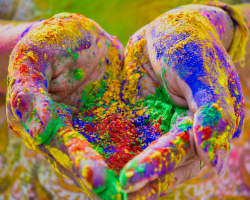Holi

Holi

Originally a festival to celebrate good harvests and the fertility of the land, Holi has several traditional links with legends.
According to one popular legend, the word Holi is derived from the demoness Holika. She was the sister of Hiranyakashyap, a demon king, who, having defeated the Gods, proclaimed his own supremacy over the Universe. Enraged by his son Prahlad’s ardent devotion to Vishnu, Hiranyakashyap decided to punish him. He took the help of his sister Holika, who was immune to damage from fire. Holika carried Prahlad into the fire, but divine intervention destroyed her and saved Prahlad. Thus, Holi is celebrated to mark the burning of the evil Holika, signifying the triumph of good over evil. This is commemorated by burning huge bonfires on the eve of Holi as a symbolic representation.
In many parts of India, however, Kama – the God of love, is the presiding deity. According to an ancient legend, Shiva was deep in meditation, oblivious to Parvati, the daughter of the Himalayas, who sought his love. Kama (the Indian version of Cupid) shot an arrow towards Shiva, disturbing his meditation. Enraged, Shiva destroyed Kama, reducing him to a heap of ashes. Kama was later resurrected by the intercession of Parvati.
Yet another legend holds that Holi is linked to the female demon Putana, who tried to kill the child Krishna by making him suckle her poisoned breasts. However, Krishna sucked very hard, draining the life out of Putana. Legend adds that her body disappeared, and the cowherds of Mathura burnt her effigy. Since then, Mathura has been the main center for Holi.
Holi announces the arrival of spring and the passing of winter. Young and old alike are drenched with colors. On Holi, people are suddenly caught unawares with colors being poured from the terraces and roofs of houses, bursting balloons, or long pistons squirting colored water. People in small groups are seen singing, dancing, and throwing colors on each other. They also consume food laced with bhang, an aphrodisiac that leaves one feeling light and happy.
Holi is celebrated throughout India, but it is more predominant in North India. Preparations for the festival begin a week ahead. Houses are given a fresh coat of color, beautiful floral designs are drawn at the entrance, and powdered colors and spraying pistons are bought.
In earlier days, the colors were extracted from a flower that blossoms only during this festival, and the pistons were made of bamboo sticks. But over the years, colors are made artificially, and pistons made of different materials are available in various designs.
Usually, people burn the Holika tree on the eve of Holi. A bonfire is lit in the evenings, with an effigy of Holika. Brahmins circle the fire seven times, reciting religious verses. Folklore and dances are performed around the fire to welcome the new season. On the morning of Holi, people have fun with colored water. Men, women, and children all participate in this merry-making. In the evening, youngsters play with dry colors and seek elders’ blessings.
Feasts are prepared for Holi, be it Dahi Wada or a preparation of raw jackfruit or the traditional Malpua (a dessert made of maida, milk, sugar, and dry fruits). Holi is as important a festival as Dusserah and Diwali. It is also distinguished in certain regions like Bengal where it is marked by performances of Dolothsava in which the image of Lord Vishnu is swayed in decorated swings, and colored powder is offered to the God.
In South India, Holi is not celebrated with as much fervor as in North India. But the spirit of communal harmony is very high. People indulge in merry-making, and playing with colored waters is a common sight. Peasants visit homes singing folklore and asking for small tips.
This animated festival is also associated with the immortal love of Krishna and Radha, and hence, Holi is spread over 16 days in Vrindavan as well as Mathura – the two cities with which Lord Krishna shared a deep affiliation. Apart from the usual fun with colored powder and water, Holi is marked by vibrant processions, which are accompanied by folk songs, dances, and a general sense of abandoned vitality.
The color, noise, and entertainment that accompany the celebration of Holi bear witness to a feeling of oneness and a sense of brotherhood. No other festival brings home the lesson of spiritual and social harmony as well as the festival of Holi.